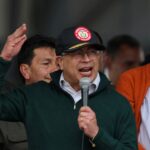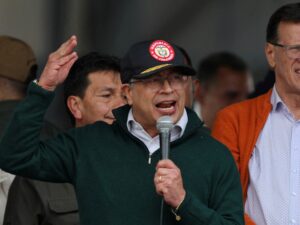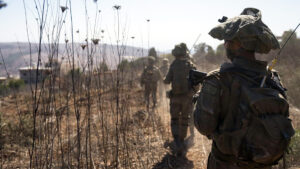
Despite the US government’s incessant claims that it is working to secure a ceasefire, the genocide that has unfolded in Gaza over the past year has been a joint US-Israeli endeavour. Israel would not be able to inflict anything approaching the degree of violence it has on the Palestinian people without American weapons, intelligence, and political cover.
To pursue these policies, the US government needed a critical mass of the American population to support or go along with its policy of working with Israel to exterminate the Palestinians. To sustain it, President Joe Biden’s administration has adopted a staunchly pro-Israeli narrative and sought to justify Israeli actions and its own by citing Israel’s “right to self-defence”.
Influential voices in American media have also contributed to creating the necessary ideological conditions for public acceptance of US-enabled Israeli atrocities. They, along with the Biden administration, are partially responsible for the genocide in Gaza.
In 2003, the International Criminal Tribunal for Rwanda (ICTR) issued the first-ever convictions for incitement to genocide, concluding that “the genocidal harm that was caused by [Radio Télévision Libre des Milles Collines] programming” during the Rwandan genocide of 1994. Incitement to genocide is “inchoate”, that is, a crime that promotes the commission of one crime while also being an offence itself.
For the ICTR, demonstrating that someone has committed incitement to genocide does not necessarily require showing that their speech directly led a person to carry out genocidal acts. In one scholar’s view, for a genocide to occur, a climate must be created to enable such crimes to be committed.
Commentary that has appeared in The New York Times, The Washington Post, and The Wall Street Journal can be thought of in these terms. Pundits in these papers have engaged in a form of incitement to genocide, albeit a distinct one because Americans do not need to go to Palestine and kill people to contribute to the genocide; they just have to acquiesce to their government’s participation.
Gregory S Gordon’s Atrocity Speech Law: Foundation, Fragmentation, Fruition offers thought-provoking approaches to incitement to genocide and other forms of hate speech. Applying his arguments to US media coverage of Palestine-Israel after October 7, 2023 suggests that much of it amounts to genocide incitement. Gordon, an international legal scholar and former prosecutor at the ICTR, contends that demonisation is a form of incitement. This practice, he writes, centres on “devils, malefactors, and other nefarious personages”.
A piece published in The New York Times last October engaged in precisely that. “If Gaza is the open-air prison that so many of Israel’s critics allege, it’s not because Israelis are capriciously cruel but because too many of its residents pose a mortal risk,” the article contended. Here broad numbers of Palestinians in Gaza are cast as deadly criminals deserving collective punishment. In the same vein, an October 7 Wall Street Journal editorial told us that Israel is in a “rough neighbourhood”.
A Washington Post op-ed published a few days later claimed Israel is part of a “battle against barbarism”. In another piece, a columnist wondered whether “it might be pointless to apply political logic to the horrors perpetrated by the millenarian religious fanatics of ISIL or Hamas. They are driven by a religious imperative to slaughter ‘infidels’ and ‘apostates’, regardless of the consequences.”
A piece published in The New York Times in November offered a similar formulation, describing Hamas as a “terrorist death cult”. Characterising Hamas in this misleading, overly simplistic manner – never mind vilifying Palestinians tout court – as atavistic savages conveys the message that they are irrational barbarians and must be crushed, no matter the cost.
According to Gordon, attempting to persuade an audience that ongoing atrocities are morally justified is another form of incitement, one that has been widespread in the Gaza coverage. The direction Israeli policy was heading was easy to identify as early as October 13 of last year when Raz Segal, a professor of Holocaust and genocide studies, wrote that Israel had undertaken a “genocidal assault on Gaza [that] is quite explicit, open, and unashamed”.
Nevertheless, three weeks into the Israeli offensive, a piece published in The Washington Post rejected ceasefire calls and even the idea that Israel should “limit its response to precision air strikes and commando raids to take out high-level Hamas operatives and to free hostages”. It argued that if Israel agreed to a ceasefire at that point, it would “be tantamount to rewarding aggression and inviting more of it in the future”.
The subtext is that Israel’s actions are ethically defensible, no matter that the US and Israel had killed nearly 3,800 Palestinians in the first 13 days of the assault on Gaza, wiping out entire families. At that time, Amnesty International Secretary General Agnès Callamard described Israel’s actions as “pulveriz[ing] street after street of residential buildings[,] killing civilians on a mass scale and destroying essential infrastructure” while further limiting what could enter Gaza so that the Strip was “fast running out of water, medicine, fuel and electricity”.
The November New York Times op-ed mentioned above put forth the rather novel view that Palestinians would ultimately benefit from being slaughtered. It magnanimously conceded that “in the short term, of course: Palestinian lives would be saved if Israel held its fire.” But the article asserted that, if the US-Israeli assault ended with Hamas still governing Gaza, this outcome would mean “a virtual guarantee for future mass-casualty attacks against Israel, for ever-larger Israeli retaliation, and for deeper misery for the people of Gaza.”
According to this logic, it is virtuous for the US and Israel to help Palestinians by going on with policies that had turned Gaza into “a graveyard for thousands of children” and “a living hell for everyone else”.
Attempts to legitimise the mass deaths inflicted by the US and Israel did not disappear after the initial weeks of the slaughter in Gaza. In January, an op-ed in The Washington Post argued that the death and destruction in Gaza are a tragedy for its people but “primary blame must lie with Hamas, because it launched an unprovoked attack on Israel”.
Suggesting that the US-Israeli campaign is responding to an “unprovoked” Palestinian attack implies that the campaign is justifiable. This position does not withstand minimal scrutiny: in the days, weeks, and months leading up to October 7, Israel repeatedly bombed Gaza and shot Palestinians at the fence surrounding the territory while subjecting them to a brutal, illegal siege, to say nothing of the more than 75 years of dispossession leading up to that day.
Because Israel was carrying out acts of war against Palestinians in Gaza prior to October 7, Israel’s actions since then cannot be understood as a form of self-defence. Yet US-Israeli apologists in the American media have said “Israel has the right and duty to defend itself”, presenting the US-Israeli crusade as righteous and thus worthy of support. No matter that Israel “defending itself” has entailed an “unrelenting war” on Gaza’s health system and featured air strikes on hospitals and health workers as well as killing Palestinians at the deadliest rate of any conflict this century.
At the end of February, a Wall Street Journal editorial criticised Palestinian American Congresswoman Rashida Tlaib and others on the grounds that “the ceasefire they want would have the effect of leaving [Hamas] fighters alive and free to rebuild their terror state. The suffering in Gaza is terrible, but the main cause is Hamas’s use of civilians as human shields.”
At that point, Israel had killed at least 7,729 children. For the Journal, it appeared this horror was justified if Hamas was defeated; the tens of thousands of dead Palestinian civilians could be explained away by dubiously and selectively employing the concept of human shields.
In March, another column in The New York Times rehashed the same well-worn canards to try and persuade readers that US-Israeli conduct in Gaza was just, contending that “Hamas started the war” and that “Israel is fighting a tough war against an evil enemy that puts its own civilians in harm’s way.” The Biden administration, the piece advised, should “help Israel win the war decisively so that Israelis and Palestinians can someday win the peace”.
Two weeks earlier, UN special rapporteur on the right to food Michael Fakhri had denounced Israel’s forced starvation of Palestinians in Gaza and said “this is now a situation of genocide.” For some American opinion-makers, it is morally right for the US to continue being party to that.
The media outlets that published these articles could have given more space to sober reflections on how to generate peace, justice, and liberation across historical Palestine. Instead, they have given platforms to those who have helped incite the carnage America and Israel have wrought. When the history of this grisly period is written, there needs to be a chapter on the media outlets that helped ignite a genocide and helped keep it going.
The views expressed in this article are the author’s own and do not necessarily reflect Al Jazeera’s editorial stance.











More Stories
Israeli protesters interrupt Netanyahu’s speech as Gaza truce talks resume
‘Venom: The Last Dance’ misses projections as superhero films’ grip on theaters loosens
Colombia’s president faces trouble – but blames opposition for ‘coup’